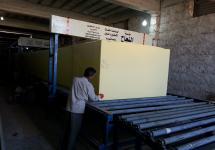Any, even the smallest, enterprise is characterized by many economic parameters. These include such concepts as - cost, productivity and many others. One of the key parameters, undoubtedly, is the type of production - single, serial or mass.
This parameter is important at the stage of developing a business plan. At the very least, it is used in the selection of the necessary equipment. For example, for the manufacture of fasteners, you can use a commercially available universal turning and milling equipment, or you can also use upsetting machines. The difference lies in its performance. That is, in the amount of products manufactured per unit of time.
Production types classification
The type of production is a set of technical, organizational and economic parameters that are unique to it. This set includes such concepts as - the product release program, the frequency of the working cycle and some others.
In practice, any company can organize the release of products in a single, serial and mass order:
- A single type is a form when products are produced in minimum quantities (piece by piece).
- Serial type is a form of organization when finished products are produced in a certain quantity and at a specified frequency.
- The mass type is a form of organization of the enterprise, which implies the release of a certain range of products, which can be homogeneous in purpose, design features and manufacturing technology.
For each type, there is also a mathematical characteristic, which is called the coefficient of consolidation of operations. This is the ratio between the number of technological transitions at the workplace and the total number of jobs at the site.
Single production type
The key features of a single form of work are that an enterprise plan can consist of a large assortment of products. As a rule, production is planned in certain quantities. But you need to understand that the range of products is not sustainable.
As a result of this instability, the limited manufacturing of products leads to some restrictions in the use of all engineering and technical capabilities.
As a result, the number of original parts increases and the volume of standardized assemblies decreases.
Each part or assembly, with this type of organization of the enterprise, has a constructive uniqueness, tasks to be solved and other features. The production process of such products has intermittent cycles. It takes quite a long time to release a part or assembly unit. In addition, universal machines are used to ensure the work, and the assembly process is carried out manually, by personnel with universal knowledge and skills.

As an example of a single form of product release, we can consider the manufacture of stamping equipment or molds.
Workshops for the production of piece goods consist of production sections, which are organized according to the technological principle.
This type of organization of the company's work is characterized by:
- Great labor intensity.
- Highly qualified staff.
- High material costs.
In the cost of a finished part or assembly unit, a significant share is occupied by the payroll fund. It can be up to 25% or more.
Serial type of production
The serial type is perhaps the most widely used. Its main characteristic is the constant release of a wide range of products. It should be noted that the range of products produced during the year is wider than that produced every month.

Products that are produced in large volumes allow the unification of technological operations. Organize the release of standardized parts, which may also be included in other assembly units. All this leads to a decrease in the cost of finished products.
This type of manufacturing of finished parts or assembly units is typical for the machine tool industry, etc. It is organized in such a way that several technological transitions are fixed at the workplace. This provides the worker with the opportunity to master the tool and equipment, obtain the necessary knowledge and skills, and constantly improve technological operations.
The serial type implies the periodicity of the release of finished parts, and this allows you to reduce the cost of obtaining finished products.
There are the following subtypes of batch production: small (piece), batch, mass.
Small batch is, in fact, a transitional stage from piece to serial. The release of products can be carried out in small batches. By the way, one of the competitive factors is the company's ability to produce unique products in small batches for special orders.

The introduction of computer technology significantly increases the flexibility of the enterprise. For example, it became possible to produce several products on one line with minimal changeover costs.
Large-scale production is a transitional stage to mass production of products. It is characterized by the fact that the manufacture of products is carried out in large volumes over a long period of time.
Mass production type
The main feature of this method is the receipt of the same type of parts, catch and finished products in large volumes and for a significant period of time. Another feature is that at enterprises that are engaged in mass production, the range of manufactured products is significantly limited. This approach translates into cost-effectiveness from the use of standardized and interchangeable parts.

Units of this type of product practically do not differ from each other, non-critical differences in some characteristics are allowed.
A distinctive feature of mass production is that it is characterized by a high level of mechanization and automation of technological operations. This method of producing finished products has been introduced at enterprises producing cars, clothing, etc.
Substantial volumes of production of parts and assemblies ensure the use of various types of automated equipment. Technological processes at such an enterprise are distributed among workplaces. They perform one or more similar operations using a limited number of parts and assemblies.
A well-developed technological process, the use of automated equipment, tooling allows the use of the labor of qualified personnel.
An example of a mass type is the manufacture of electrical fittings (sockets, switches) or hardware.
Characteristics of types of production
The type of product release affects the organization of production, its management and financial and economic indicators, then the overall efficiency of the enterprise as a whole.
The growth of technical equipment and production volumes of finished products at the time of the transition from single to serial production, and mass production reduces the need for the use of human labor. Accordingly, the cost of finished products is reduced. By the way, Ford factories can be cited as an example. At the beginning of the twentieth century, the first cars were produced on them on stocks. With the introduction of conveyor production, the volume of finished products rose sharply, and their price for consumers fell.

Based on the above, some generalizations can be made. The possibilities of piece production include the fact that the range of manufactured products is practically unlimited, most of the products are of a purely individual character. For the production of piece goods, universal equipment is used, for example, turning and milling machines. When developing working documentation, in particular, technological documentation, designers are engaged in the creation of an enlarged technological process, not just one part, but for a unit or a product as a whole. For the production of piece goods, highly qualified engineering and working personnel are involved. All of these factors lead to the fact that the cost of piece goods is prohibitively high.
For the organization of serial production of products, universal or specialized equipment is involved. Products are released at regular intervals. There is no need to attract highly qualified specialists to carry out the work.
During the organization of mass production, specialized equipment is used. To work on it, it is enough to use engineering and working personnel with low qualifications.

In fact, an enterprise can operate several types of production. But this can be explained by the fact that the company does not have too high specialization. For example, at one time the automobile plant them. Likhachev (ZIL), serially produced trucks intended for use by the military, in agriculture, construction, and many other industries. At the same time, a piece production of cars for the transportation of top officials of the state was organized at this enterprise.
Features of planning different types of products
Each of the considered types of production has its own production system.
There is a fixed positional layout. Such a system implies that the assembly unit is stationary, and the necessary resources are supplied to the place of work as and when the need arises. This method is used in the implementation of a variety of projects. Sometimes this method is called island and it is sometimes used in the manufacture of turbines. Such planning is considered temporary and is valid for the duration of the project. The main difficulty in implementing this design method lies in the proper allocation of resources.

Another planning method is operational functional. With this method, the equipment is placed by type or by the attribute of the work performed. That is, they organize areas for various types of work, for example, a site for working with body parts. Accordingly, parts and units of the product move along different technological routes. This type has certain difficulties with the optimization of traffic flows.
For mass production, linear or in-line layout is most often used. With this form of planning, the parts produced go through the same operations. One of the key characteristics of such a production process is that all technological processes are divided into simple operations that are performed on specialized equipment in series. A set of such equipment is called a production line.
In other words, the movement of parts and the catch of the future product is carried out continuously. This type of planning assumes that the workplaces must have the same bandwidth. Otherwise, the release of finished products will be intermittent.
The planning of the enterprise is carried out for a certain period of time. This approach provides flexibility in the work cycle, allows you to keep records and control over all resources (material, human, financial) involved in the enterprise system.


